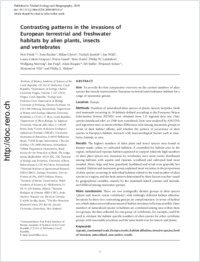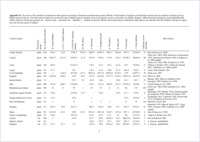Contrasting patterns in the invasions of European terrestrial and freshwater habitats by alien plants, insects and vertebrates
- Pyšek, Petr Institute of Botany, Academy of Sciences of the Czech Republic, Průhonice, Czech Republi - Department of Ecology, Charles University Prague, Czech Republic
- Bacher, Sven Ecology and Evolution Unit, Department of Biology, University of Fribourg, Switzerland
- Chytrý, Milan Department of Botany and Zoology, Brno, Czech Republic
- Jarošík, Vojtěch Institute of Botany, Academy of Sciences of the Czech Republic, Průhonice, Czech Republi - Department of Ecology, Charles University Prague, Czech Republic
- Wild, Jan Institute of Botany, Academy of Sciences of the Czech Republic, Průhonice, Czech Republi
- Celesti-Grapow, Laura Department of Plant Biology, La Sapienza University, Rome, Italy
- Gassó, Núria Centre de Recerca Ecològica i Aplicacions Forestals (CREAF), Universitat Autònoma de Barcelona, Spain
- Kenis, Marc CABI Europe-Switzerland, Delémont, Switzerland
- Lambdon, Philip W. Global Programmes Department, Royal Society for the Protection of Birds, Sandy, Bedfordshire, UK
- Nentwig, Wolfgang Institute of Ecology and Evolution, University of Bern, Switzerland
- Pergl, Jan Institute of Botany, Academy of Sciences of the Czech Republic, Průhonice, Czech Republi
- Roques, Alain National Institute of Agronomical Research, INRA, Orléans, France
- Sádlo, Jiří Institute of Botany, Academy of Sciences of the Czech Republic, Průhonice, Czech Republi
- Solarz, Wojciech Institute of Nature Conservation, Polish Academy of Sciences, Krakow, Poland
- Vilà, Montserrat Estación Biológica de Doñana, Sevilla, Spain
- Hulme, Philip E. The Bio-Protection Research Centre, Lincoln University, Canterbury, New Zealand
-
08.02.2010
Published in:
- Global Ecology and Biogeography. - 2010, vol. 19, no. 3, p. 317-331
Aquatic
continental scale
Europe
exotic
habitat affinities
invasive species
level of invasion
naturalized
non-native
weeds
English
Aim To provide the first comparative overview on the current numbers of alien species that invade representative European terrestrial and freshwater habitats for a range of taxonomic groups. Location Europe. Methods Numbers of naturalized alien species of plants, insects, herptiles, birds and mammals occurring in 10 habitats defined according to the European Nature Information System (EUNIS) were obtained from 115 regional data sets. Only species introduced after ad 1500 were considered. Data were analysed by ANCOVA and regression trees to assess whether differences exist among taxonomic groups in terms of their habitat affinity, and whether the pattern of occurrence of alien species in European habitats interacts with macroecological factors such as insularity, latitude or area. Results The highest numbers of alien plant and insect species were found in human-made, urban or cultivated habitats; if controlled for habitat area in the region, wetland and riparian habitats appeared to support relatively high numbers of alien plant species too. Invasions by vertebrates were more evenly distributed among habitats, with aquatic and riparian, woodland and cultivated land most invaded. Mires, bogs and fens, grassland, heathland and scrub were generally less invaded. Habitat and taxonomic group explained most variation in the proportions of alien species occurring in individual habitats related to the total number of alien species in a region, and the basic pattern determined by these factors was fine-tuned by geographical variables, namely by the mainland–island contrast and latitude, and differed among taxonomic groups. Main conclusions There are two ecologically distinct groups of alien species (plants and insects versus vertebrates) with strikingly different habitat affinities. Invasions by these two contrasting groups are complementary in terms of habitat use, which makes an overall assessment of habitat invasions in Europe possible. Since numbers of naturalized species in habitats are correlated among taxa within these two groups, the data collected for one group of vertebrates, for example, could be used to estimate the habitat-specific numbers of alien species for other vertebrate groups with reasonable precision, and the same holds true for insects and plants.
- Faculty
- Faculté des sciences et de médecine
- Department
- Département de Biologie
- Language
-
- English
- Classification
- Biological sciences
- License
- License undefined
- Identifiers
-
- RERO DOC 17459
- DOI 10.1111/j.1466-8238.2009.00514.x
- Persistent URL
- https://folia.unifr.ch/unifr/documents/301555
Other files
Statistics
Document views: 104
File downloads:
- bac_cpi.pdf: 203
- bac_cpi_sm.pdf: 96

